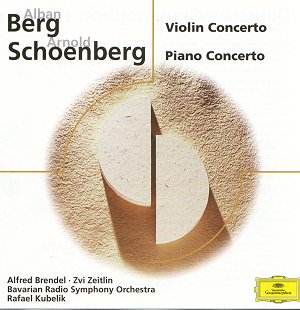ARNOLD SCHOENBERG (1874-1951)
Violin Concerto (1936)
Piano Concerto (1942)
ALBAN BERG (1885-1935)
Violin Concerto (1935)
 Zvi Zeitlin (violin)
Zvi Zeitlin (violin)
Henryk Szeryng (violin - Berg)
Alfred Brendel (piano)
Bavarian Radio SO/Rafael Kubelik
rec 1971/72
 ELOQUENCE 469 606 2
[77.29]
ELOQUENCE 469 606 2
[77.29]
Crotchet
Commentary on the Eloquence series

This is an exceedingly generous disc and one assembled with an eye to an
apt sequence. I was not familiar with Szeryng's Berg but the two Schoenberg
items are well known to anyone who collected yellow label LPs during the
1970s.
I had not heard the Berg for many years. Renewing acquaintance I was struck
by the works it had influenced, pre-echoing their way through its pages.
The opening predicts Samuel Barber's Knoxville with which the concerto
shares a similar spirit. The violin concertos by Barber, Frankel and, above
all, William Schuman, are also influenced by the Berg.
The dodecaphonic theme continues but with greater force and less emotional
dilution with the two concertos from Schoenberg's U.S. years. The piano concerto
is hyperactive, mystical, jagged and sour, even in repose. The spirit of
line is not lost and a dank romanticism lours. I have not compared this with
the Peter Serkin/Boulez coupling on Erato (also with the Schoenberg violin
concerto but without the Berg) but the sound is staggeringly good, denied
only a silky texture when very loud. The pizzicato episodes at the start
of the Molto allegro make an astonishing approach towards the illusion of
reality.
The violin concerto predates the piano concerto by six years. While the first
movement's poco allegro is angular there is relief in the intermittently
gentler contours of the andante grazioso with its tattered shreds
of lullaby, cantique and passacaglia.
Kubelik and the Bavarians are a constant throughout these three works. They
are unfailingly alert and vital.
A word or several about the design of the Eloquence marque: minimalistically
tasteful, monochrome but with a subtle colour splash for the DG shield and
the central abstract design. The approach is consistent across the Eloquence
brand. Spine colour coding is also used to identify the musical genre.
The two Schoenberg works are tougher going than the Berg though far from
impossible.
Not a disc for romantics. Those sated with too much Rachmaninov, Bax or Arnold
will find, however, that it clears the head. At the very least they will
return to their core repertoire with a sense of renewal.
Congratulations to Universal for taking the decision to include this far
from easy choice in their series. I must be more careful in condemning the
majors for lack of adventure.
Rob Barnett

